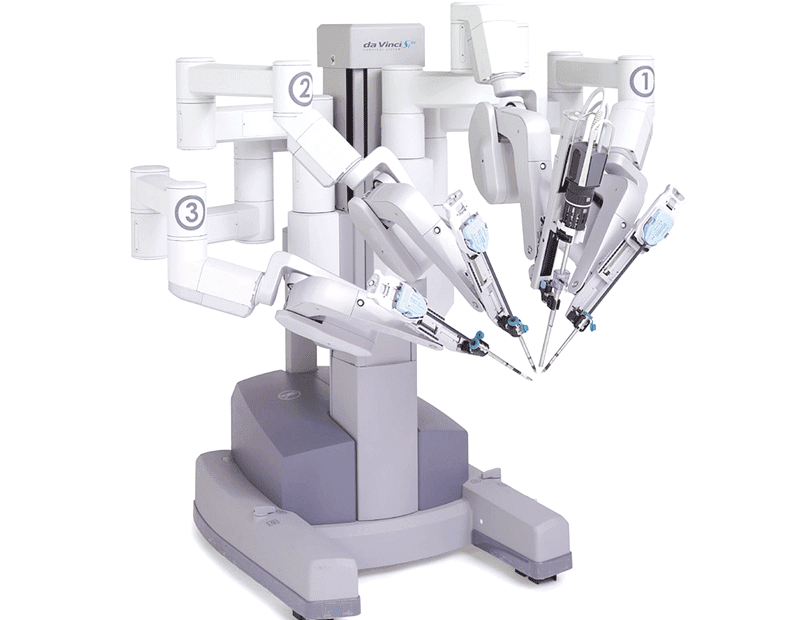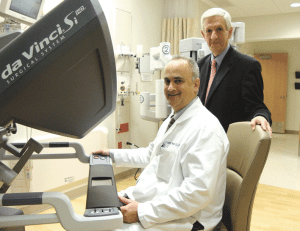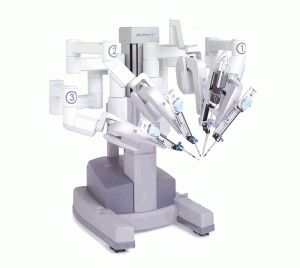
The Cutting Edge
Mercy Medical Center Expands Its Reach in Robotic Surgery

Dr. David Kelley (right, with Dr. Scott Wolf) says the technological advancement of robotic surgery makes something that was good even better.
Wolf, chief medical officer and vice president of Medical Affairs at Mercy Medical Center in Springfield, was speaking of the da Vinci Si, the latest word in robotic surgery, which was recently delivered to the hospital. While Mercy has for some years owned an earlier DaVinci surgical robot system, this state-of-the-art device expands on that platform.
Elaborating on his metaphor, Wolf said that not only does the Si provide greater resolution, but the hospital invested in the constituent simulator to act as a training and practice tool for the many complex procedures available with the robot.
“The enhancement of technology in this instance is making something that was good even better,” said Dr. David Kelley, chief of Urology and chief of Surgery at Mercy.
Robotic surgery as a concept is not new to the hospital. In fact, Mercy committed several years ago to investment in the high-tech machinery. “And it’s not just the surgeon,” Wolf said. “You need an extraordinary team devoted to da Vinci surgery.”
For Kelley, a life’s work in surgery has been transformed in recent years. “Laparoscopy has been around for a while, and it was a great benefit, but that was handheld,” he said, adding that the latest da Vinci technology is able to provide invaluable assistance to surgical teams on long, complex procedures.
“The ability to magnify 10 times greater — it’s like Superman,” he added. “And the robot can do things that my hand cannot do, in spaces my hand cannot go, with dexterity.”
Kelley noted that, when he started his practice 25 years ago, the common thought was that one needed to travel far afield of the Pioneer Valley in order to have access to the most current advances in medicine. But this native Springfield resident said that’s no longer the case.
“Machinery such as this gives Mercy, and Western Mass., a competitive edge,” he added. “There is talent that we can attract to our practice because of the hospital’s commitment to bringing in this type of technology. They want to practice here.”
Wolf and Kelley gave BusinessWest a sneak peek at the latest da Vinci equipment at Mercy, not yet fully assembled. While it will be a few weeks before both the robot is fully operational and the robotic-surgery program brought up to compliance with this model, the doctors agreed that this is the cutting edge of medicine.
The Sharper Image
Wolf stated that, while the prior DaVinci system was an important step in Mercy’s commitment to offering robotic surgery, the Si is without compare.
“It offers a tremendous amount of operative advantages for the surgical technique,” he explained, “and it affords our patients a tremendous amount of clinical advantages, from the perspectives of decreased blood loss, decreased discomfort, and a much-quicker recovery time. Ultimately, the goal is to get you back to your normal life sooner.”
A key distinction with the Si is the enhanced, high-definition vision of the operative field, equivalent to 1080i in televisions, Wolf said. It has ability to magnify up to 10 times, “so you can imagine that the visual clarity of the operative field is that much more precise.”
Kelley offered a contrast between the robotic and traditional forms of surgeries. “Before, an open prostatectomy would mean a week in the hospital, and blood loss could be significant,” he explained. “With a robotic prostatectomy, it’s rare that anyone needs blood. In fact, that would be unusual. Blood loss is down to very, very little, which is a major departure from what it had been in the past.”
Robotic surgery at Mercy has heretofore been focused on intra-abdominal procedures. “The urologists first used it on the prostate, we have used it for cystectomies, we’ll remove a bladder, we do nephrectomies — removal of a kidney, urethral surgeries,” Kelley said.
“The entire genitourinary tract outside of the genitals themselves has been accessed through the robot,” he continued. “Likewise, gynecologists have used it through the abdominal cavity to do ovarian surgery, uterine surgery, and prolapses.” He added that the hospital is exploring the possibility of thoracic surgery with the da Vinci as well.
Because of the lessened trauma of robotic surgery, Kelley said that recovery times have been cut significantly. “Patients are often discharged within 24 to 48 hours,” he noted. “The patient needs to get up early, and ambulation is important. But, of course, to achieve that, you need the best team, and we at Mercy have assembled this team.”
Mission Accomplished
The Si has streamlined the mechanics of this latest robot. While the layout of two modules has remained — a control booth in which the surgeon sits and manipulates the controls, and the actual surgical robot itself — the connections have all been condensed into a single cable from one machine to the other.
Also, the function of attaching the patient to the surgical platform has been fine-tuned. Kelley called this “side docking.”
“And it all has to be precise in placing the patient on the table,” he went on. “The placement can’t even be a little off. The manufacturer saw the potential problems with the original model and determined that it can take so long for the staff to figure out how to dock the robot with the patient, that they figured out how to make it easier. The robot and the patient can get together more safely and easily.”
Both doctors credited the many employees associated with Mercy’s robotic-surgery procedures, from surgeons and nurses to the OR staff. “You can’t just bring in a piece of equipment like this without an extraordinary team to use it,” Wolf said.
To help better prepare that network of medical professionals, Mercy purchased a simulator module complementary to the Si.
“It replicates the actual surgical cases that the surgeon is about to perform,” Wolf explained. “It’s giving the ability to assist from a training perspective, but also preoperatively — to get into the seat, if you will, and get the proper frame of reference.
“Not only will this help our existing surgeons,” he continued, “but for any new doctors to become skilled at these techniques. We’re one of the only facilities in the area to have that simulator.”
The learning curve for the Si will not be significant, the doctors said, because the robotic-surgery staff has been skilled in da Vinci equipment for years. “But there are newer details that we all need to be proficient on before the jump from one machine to the next,” Kelley said.
A certain number of hours must be logged on the simulator to realize that goal, and Wolf expects mid-February to be the target date for the Si to become operational. In that time, Mercy is looking at not only how this latest and greatest robotic-surgery technology can redefine the surgical theater, but how it can affect the hospital’s mission.
“We’re putting together a robotics committee to further develop Mercy as a center of excellence,” Wolf said. “The committee will establish protocols around pre- and post-operative care, intra-operative cases, and establishment of our quality metrics to truly build a program here. It’s not just delivering a machine and putting it into the OR. It’s a full robotics program.”
Wolf admitted that the Si was a significant capital investment, but one that further establishes Mercy as a vital resource in Western Mass.
“That’s reflective of our commitment to the community,” he said. “You can’t put a price tag on quality care. And this allows us to continue providing that quality care. For the last two years in a row, we’ve been voted one of America’s top 100 hospitals for value and quality, and we will continue to deliver care in that fashion, regardless of the investments that we make.
“We’re not just the community hospital that can only treat coughs and colds,” Wolf added. “We want to provide the latest to our patients, because they deserve it.”





